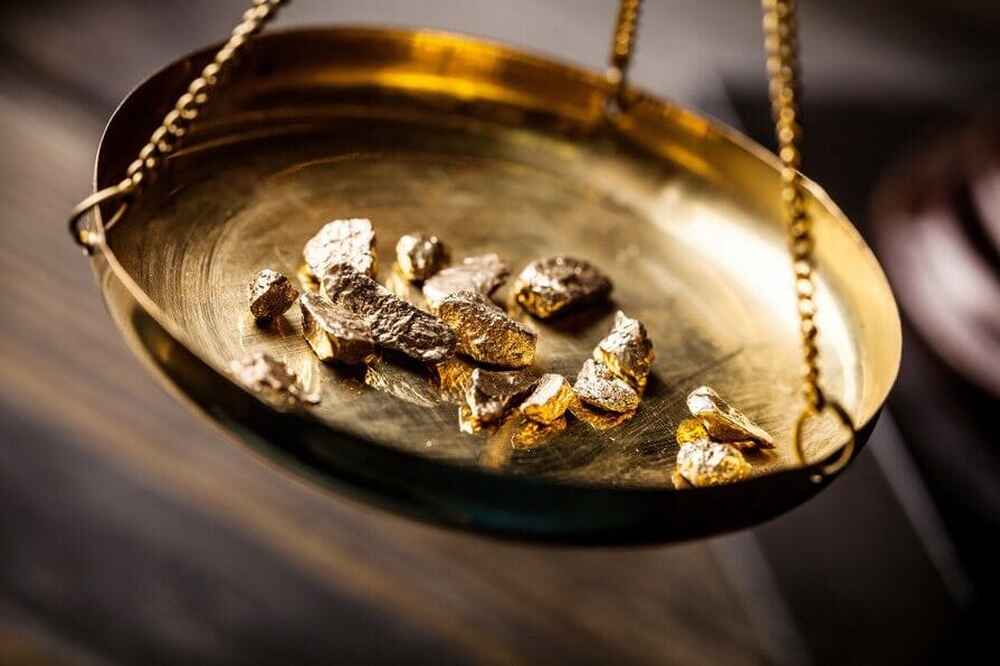The precious metals at a glance
The precious metal gold stands out strongly from other metals due to its colourfulness, its considerable weight and its resistance to environmental influences. It is one of the first metals that people used to make artefacts, especially ritual objects and jewellery.
The earliest known objects made of gold date back to the 5th millennium B.C., and gold coins are known to have been used as a means of payment from the 6th century B.C. onwards. For jewellery making, gold has the advantage that it is easy to process, as it melts even at low heat and combines with many metals to form beautiful alloys.
Rose gold: "Russian gold" or "Turk's gold" is the name given to gold alloys with a reddish shimmer because they were invented in Eastern Europe at the end of the 18th century. The rosé or red tone is produced by copper, which also gives the material its strength. Sometimes a little silver is added for better processing.
The higher the copper content, the more reddish the material shines. Although the terms rose gold and red gold are not linked to a specific ratio of gold and copper, rose gold is often used to refer to alloys with a lower copper content. The term "Russian gold", however, always refers to a gold fineness of 583.
Yellow gold: Even though pure gold also shines yellow, yellow gold is also an alloy. Additional components here are silver and copper in equal proportions. In Germany, however, the gold fineness of yellow gold may not be less than the proportion of copper or silver. Thus, the minimum content of gold and the maximum content of silver and copper for yellow gold is 33.3%.
A higher gold content than 333 or 8 carat not only increases the value of the piece of jewellery, but also intensifies the yellow tone. 750 yellow gold or 18-carat yellow gold consists of 75% gold and 12.2% each of copper and silver. The most popular, however, is 585 yellow gold, which tarnishes less than 333 gold but has a higher degree of hardness than 750 gold.
White gold: Hardly distinguishable from silver in colour, white gold comes up trumps with other qualities. In French, these white-silver shining gold alloys are called "or gris" (grey gold). The tone is created by adding metals that decolour the gold. These include silver and palladium, and sometimes iron and platinum. White gold is cheaper than platinum and has the advantage over silver that it tarnishes less.
White gold, which is produced by adding copper, nickel and zinc, is characterised by a basic strength that is particularly useful for pins, hinges and clasps. However, since some people are allergic to nickel, it is hardly ever used for jewellery today.
More expensive but more precious are white gold alloys with palladium content. Although palladium has a somewhat darker colour, the desired light tone can be created by rhodium plating at a later stage. Palladium white gold is more difficult to work with due to its density and higher melting point. Palladium is also a higher-quality precious metal that is more expensive than copper and silver. This explains the higher price of white gold jewellery compared to yellow gold jewellery and red gold jewellery with the same gold fineness.
Since the 5th millennium BC, people have been fascinated by silver and processed it into artefacts. Whether among the Egyptians, the Greeks or the Germanic tribes - silver was highly valued and at times even more sought after than gold.
Whether silver is a real precious metal is a matter of debate. This is because silver, unlike gold and the platinum metals, shows a slight reaction with hydrogen sulphide. Therefore, over time, a thin layer of black silver sulphide is deposited on the surface of silver jewellery. However, the silver itself is not damaged by this reaction. The silver sulphide can also be removed easily, e.g. with a silver cloth. For more tips on how best to clean silver jewellery, see our chapter on cleaning silver.
Did you know that the Olympic gold medal is actually just gold-plated silver? There is also a separate term for gold-plated silver: "vermeil", which means "high red" in French. So one should actually speak of the vermeil medal.
Aside from gold, silver can also be wonderfully alloyed with other metals, for example with copper or palladium. While a copper or palladium alloy primarily has a positive influence on the hardness of the silver, a proportion of the precious metal palladium of 20 to 30 percent even makes the silver resistant to tarnishing.
.The alloy sterling silver, which is made of silver and copper and has a fineness of 925 thousandths of silver, is particularly popular. Its name is derived from the British currency pound sterling, as silver pennies were once made of this alloy. Today, sterling silver is also commonly used for jewellery and cutlery. The patented Argentium™ sterling silver contains germanium instead of copper and therefore does not tarnish, unlike other silver alloys.
A final fine silver plating, i.e. a pure silver coating, can also reduce tarnishing of the silver. Good to know: Don't be misled by the term "nickel silver". Nickel silver does not contain any silver at all; instead, it consists of the base metals copper, nickel and zinc.
In the 17th century in South America, the precious metal platinum was once a thorn in the side of gold prospectors. Because when they extracted gold dust, they did not know how to separate the platinum from the gold. Since they did not recognise its value, they disparagingly called this white-grey metal platina "little silver". They also thought it was "immature gold" for a long time.
When they found larger quantities of platinum, they simply threw it back into Ecuador's rivers. Only the gold counterfeiters recognised the outstanding properties of this metal, which does not melt even in fire and is even slightly heavier than gold. Titanium, on the other hand, was only discovered in the 18th century and has many advantages due to its lightness combined with hardness.
Platinum may look more like silver, but its properties are more similar to gold. Like gold, it has a very high resistance to corrosion and oxidation, i.e. it does not change in any way when it comes into contact with other elements such as oxygen. Due to its very good pliability, it can be excellently processed into jewellery.
More valuable than silver is platinum because of its rarity. In addition, platinum alloys often have a high fineness. A well-known platinum alloy of 96% platinum and 4% copper is also called jeweller's platinum. The copper improves the hardness of the jewellery. Pure platinum is much too soft for the production of jewellery. Alternatively, the copper can be replaced by the precious metal palladium; this extremely noble alloy is then called set platinum; it is mainly used for settings.
Platinum has another advantage: unlike gold, no material loss can occur with platinum due to scratches. With platinum, scratches only lead to a slight deformation of the piece of jewellery.
When William Gregor discovered the very strong precious metal titanium at the end of the 18th century, he felt reminded of the power of the Greek deity of the Titans. And the other properties of this precious metal are also "divine": it is light and resistant to all signs of ageing, i.e. very resistant to corrosion.
Because of these qualities, titanium is the favourite of many manufacturers for watch cases and for watch straps that need to be strong and durable but light. In fact, titanium is the ninth most abundant element on earth and costs only one-twentieth of silver. However, since pure titanium is very difficult to extract, its price is 200 times that of crude steel.
Artificially produced materials - such as enamel - can also be extremely effective and noble. And the process of enamel production is always elaborate and artistic: a glass mass of quartz sand, sodium bicarbonate, potash and lime is melted on metal surfaces. The addition of metal oxides allows for extensive variations in colour, transparency and gloss.
Furthermore, the structure of the substrate can create interesting three-dimensional effects with relief character. The number of firings, the temperature and duration also have a strong effect on the result. Depending on the metal substrate, different interactions occur. It is particularly tricky for the enameller to create a specific colour tone, as this only ever becomes visible after firing. The production of enamel therefore has something almost like magic.
Watches and watch straps are often made of stainless steel, because stainless steel is a very hard and robust material that is easy to work with. More precisely, stainless steel is a metallic alloy that consists primarily of iron with a high degree of "purity". This means that iron contains very few undesirable "iron companions" (other substances such as sulphur) in percentage terms.
In common usage, stainless steel is used to refer to stainless steel, although not all stainless steel has to be stainless. For watches and jewellery, however, very high-quality stainless steel alloys are always used that are both rust and acid resistant. In addition to iron, these alloys also contain chromium and molybdenum, among other things.








